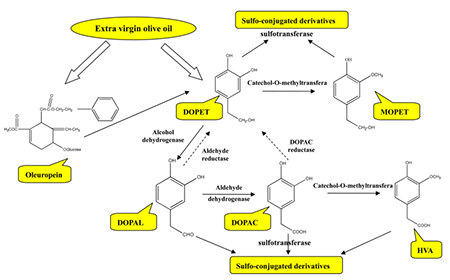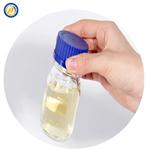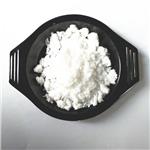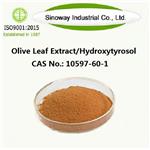The review of hydroxytyrosol
Jan 28,2022
Background
Polyphenols, widely found in vegetables, fruits, extra virgin olive oil, tea, and cocoa products, represent a group of secondary metabolites. Most of the dietary polyphenols are derivatives and/or isomers of flavones, isoflavones, flavanols, and phenolic acids, which exhibit many significant bioactivities, for example, the protection against oxidative stress and degenerative diseases[1]. As a traditional dietary model in countries of the Mediterranean basin, the Mediterranean diet was recommended by UNESCO as a nutritional prototype of worldwide value, which is characterized by an abundant intake of fruit, vegetables, legumes, cereals, fish, seafood, and so on[2].
Role in coronary heart disease and certain cancers
Several epidemiological investigations have shown that the incidence of coronary heart disease and certain cancers is particularly low in the area of the Mediterranean basin[3]. The Mediterranean diet exerts a significant anticancer, cardioprotective, and anti-inflammatory action, which is responsible for lower mortality from coronary heart disease and cancer. The use of olive oil as the main source of fat is one of the main properties of The Mediterranean diet. Evidence suggests that phenolic compounds, minor constituents in olive products, might provide health benefits. Oleuropein, hydroxytyrosol, and tyrosol, the phenolic compounds found in the highest concentrations in olive oil, are widely noted for their bioactive properties. The three compounds are closely related in structure. Hydroxytyrosol and tyrosol are structurally identical except that hydroxytyrosol has an extra hydroxyl group in the meta position. Oleuropein is an ester that consists of hydroxytyrosol and elenolic acid, which is the major phenolic compound in olive fruit and leaf, while hydroxytyrosol is the major phenolic component in olive oil. Extra virgin olive oil contains quantities of phenolic compounds with beneficial properties. Particular attention has been focused on hydroxytyrosol, which originates from the hydrolysis of oleuropein during the maturation of the olives, storage of the oil, and preparation of table olives. Hydroxytyrosol has good stability in free form; its main source in the diet is virgin olive oil, where it mainly exists in the forms of secoiridoid derivatives and acetate or free form. In addition, hydroxytyrosol could be obtained by biosynthesis. Bioconversion of oleuropein to hydroxytyrosol by lactic acid bacteria is conducted under aerobic and anaerobic conditions, which has been widely applied in the food industry for the reason that this method can increase the value of olive oil products and improve the taste of unripe olives[4]. Several studies have highlighted that hydroxytyrosol and its derivatives possess antioxidant, antimicrobial, and anti-inflammatory activities and beneficial effects on the cardiovascular system by preventing oxidative stress situations[5]. The purpose of this perspective is to discuss and elaborate the potential therapeutic effects of hydroxytyrosol and its absorption and metabolization in vivo[6-7].
The antioxidant characteristics of hydroxytyrosol
Hydroxytyrosol displays much more effective antioxidant characteristics, such as the scavenging of free radicals, breaking peroxidative chain reactions, preventing lipid peroxidation, inhibiting hypochlorous acid derived radicals, and so on, compared with other phenolic compounds in olive oil [8]. It could be used in the dermocosmetic industry for the creation of products for protecting the skin from oxidative stress or used as a preservative in the food technology. Although the bioactions of phenolic compounds are commonly related to their free radical scavenging activity current evidence strongly supports that hydroxytyrosol may also provide an indirect protection on the body through increasing the endogenous defense systems. It was reported that the antioxidants of an extra virgin olive oil rich in phenolics concentrated on pancreatic islets and liver in the mice fed with a nonpurified diet. The concentration of plasma hydroxytyrosol was greater in the mice fed with olive oil than in the control mice. The oxidized glutathione and the antioxidant capacity in plasma of the former were higher than those of the latter, and the glucose-stimulated insulin secretion became greater in the olive oil mice[9-10]. It is concluded that the protective effects of extra virgin olive oil against oxidative stress occur mainly through a direct antioxidant action and an indirect mechanism involved in higher expressions of certain enzymes with antioxidant activities.
The Anticancer Potential of hydroxytyrosol
Several epidemiological and animal research studies suggested that polyphenols might have a protective effect against some chronic degenerative diseases such as cancer. Dietary hydroxytyrosol has recently received particular attention because of its antioxidant, antiproliferative, proapoptotic, and anti-inflammatory activities, which can specifically counteract all cancer hallmarks[11]. Investigations have shown that the incidence of various cancers is much lower in the Mediterranean area compared to other countries. Besides the chemopreventive ability, the antitumor effects of olive oil phenols with high antioxidant activity have been in-depth studied because of their capacities of inhibiting proliferation and promoting apoptosis. Growing experimental evidence has suggested that, in addition to antioxidant and anti-inflammatory abilities, hydroxytyrosol and other olive oil phenols exert anticancer effects through the activation of molecular signaling pathways, leading to cell apoptosis and growth arrest in several tumor cell lines in vitro[12-13].
The cardioprotective capacity of hydroxytyrosol
Hydroxytyrosol would be an effective dietary supplement for preventive therapy of cardiovascular diseases related to insulin decrease, and the reduction of hypertension risk[14-15]. Among other healthy properties promoted by hydroxytyrosol, olive oil has beneficial effects on cardiovascular risk for its ability to reduce blood pressure and improve lipid profile. Health efficacy of olive oil intake on cardiovascular disease is greatly attributed to phenolic compounds such as hydroxytyrosol[16]. A study involving 200 healthy male volunteers indicated that the intake of different kinds of virgin olive oil with various phenolic contents reduced lipid oxidative damage and increased HDL-cholesterol. EFSA endorsed the health claim that the consumption of olive oil polyphenols contributes to the protection of blood lipids on oxidative damage[17].
The platelet function of hydroxytyrosol
Besides the ability to prevent LDL oxidation, hydroxytyrosol shows a beneficial effect on platelet function. Hydroxytyrosol derived from olive oil can inhibit platelet aggregation and production of eicosanoids in vitro, and olive derivatives share the same biological activities[18-19]. A study involving the hyperlipidemic rabbits fed with hydroxytyrosol suggested an improvement of the antioxidant status and the reduction of the size of atherosclerotic lesions[20]. In order to examine the effect of extra virgin olive oil phenolic compounds on homocysteine-induced endothelial dysfunction, the structurally related compounds had been assayed for their ability to reduce homocysteine-induced monocyte adhesion as well as the expression of intercellular adhesion molecule-1 (ICAM-1) in EA.hy.926 cells. All of the tested compounds, including hydroxytyrosol, significantly reduce the expression homocysteine-induced cell adhesion and ICAM-1. In addition, synergy of olive oil phenolic compounds in the modulation of the Hcy-induced ICAM-1 expression was investigated, and no synergistic effect has been observed when hydroxytyrosol and tyrosol are tested for their protective effects on ICAM-1 expression induced by TNFα.
The application of Hydroxytyrosol on diabetes treatment
Olea europaea leaves have been used in folk medicine to treat diabetes for many years. Supplementation with phenolic compounds of olive leaf, containing 51.1 mg of oleuropein and 9.7 mg of hydroxytyrosol per day for 12 weeks, improved the glucose regulation of insulin action and secretion in middle-aged overweight men. Insulin sensitivity and pancreatic β-cell secretory capacity were significantly improved in the people at risk of developing the metabolic syndrome. It was hypothesized that dietary antioxidants could reduce the risk of diabetes since oxidative stress plays a role in the pathogenesis of insulin resistance. Specific dietary strategies may be helpful in the prevention of this disease by improving glucose homeostasis. Hydroxytyrosol supplementation to surviving diabetic rats greatly decreased the activities of intestinal lactase, lipase, maltase, and sucrose and enhanced the activities of superoxide dismutase, catalase, and glutathione peroxidase. Moreover, significant decreases were observed in the level of thiobarbituric acid reactive substances and the activity of lactate dehydrogenase in diabetic rat pancreas after hydroxytyrosol administration. In addition, hydroxytyrosol increased lipid profile in diabetic rats through lowering the content of LDL-cholesterol and triglycerides and increasing HDL-cholesterol content. These properties of hydroxytyrosol are valuable when it is used as a therapeutic agent, especially as anti-hypocholesterolemic and diabetic drugs in biotechnological applications. A long period of oxidative stress and inflammatory responses will cause many diseases. A proinflammatory cytokine plays an important role in the pathogenesis of chronic and autoimmune diseases. Some data shows that the intake of polyphenols such as oleuropein and hydroxytyrosol can affect the formation of advanced glycation end products and their interaction with respective receptors, and modulate chronic inflammatory diseases, for example, type II diabetes, rheumatoid arthritis, and inflammatory bowel disease.
Pharmacokinetic analysis and metabolism pathways of hydroxytyparosol
As the Figure 1 showed, pharmacokinetic analysis and metabolism pathways of exogenously administered hydroxytyparosol in rats. DOPET is hydroxytyparosol; MOPET is 4-hydroxy-3-methoxy-phenylethanol; DOPAL is 3,4-dihydroxy-phenylacetaldeyde; DOPAC is 3,4-dihydroxy-phenylacetic acid; HVA is 4-hydroxy-3-methoxy-phenylacetic acid[20].

Figure 1 Pharmacokinetic analysis and metabolism pathways
Reference
1 Han, X. Z.; Shen, T.; Lou, H. X. Dietary polyphenols and their biological significance. Int. J. Mol. Sci. 2007, 8, 950−988.
2 Bach-Faig, A.; Berry, E. M.; Lairon, D.; Reguant, J.; Trichopoulou, A.; Dernini, S.; Medina, F. X.; Battino, M.; Belahsen, R.; Miranda, G.; Serra-Majem, L. Mediterranean diet pyramid today. Science and cultural updates. Public Health Nutr. 2011, 14, 2274− 2284.
3 The Local-Food Nutraceuticals Consortium. Understanding local Mediterranean diets: a multidisciplinary pharmacological and ethnobotanical approach . Pharmacol. Res. 2005, 52, 353-366.
4 Santos, M. M.; Piccirillo, C.; Castro, P. M. L.; Kalogerakis, N.; Pintado, M. E. Bioconversion of oleuropein to hydroxytyrosol by lactic acid bacteria. World J. Microbiol. Biotechnol. 2012, 28, 2435−2440.
5 Burattini, S.; Salucci, S.; Baldassarri, V.; Accorsi, A.; Piatti, E.; Madrona, A.; Espartero, J. L.; Candiracci, M.; Zappia, G.; Falcieri, E. Anti-apoptotic activity of hydroxytyrosol and hydroxytyrosyl laurate. Food Chem. Toxicol. 2013, 55, 248−256.
6 Rodriguez-Gutierrez, G.; Duthie, G. G.; Wood, S.; Morrice, P.; Nicol, F.; Reid, M.; Cantlay, L. L.; Kelder, T.; Horgan, G. W.; Guzman, J. F. B.; de Roos, B. Alperujo extract, hydroxytyrosol, and 3,4- dihydroxyphenylglycol are bioavailable and have antioxidant properties in vitamin E-deficient ratsua proteomics and network analysis approach. Mol. Nutr. Food Res. 2012, 56, 1131−1147.
7 Visioli, F.; Bellomo, G.; Galli, C. Free radical-scavenging properties of olive oil polyphenols. Biochem. Biophys. Res. Commun. 1998, 247, 60−64.
8 Bernini, R.; Crisante, F.; Barontini, M.; Tofani, D.; Balducci, V.; Gambacorta, A. Synthesis and structure/antioxidant activity relationship of novel catecholic antioxidant structural analogues to hydroxytyrosol and its lipophilic esters. J. Agric. Food Chem. 2012, 60, 7408−7416.
9 Jemai, H.; Bouaziz, M.; Fki, I.; El Feki, A.; Sayadi, S. Hypolipidimic and antioxidant activities of oleuropein and its hydrolysis derivative-rich extracts from Chemlali olive leaves. Chem.- Biol. Interact. 2008, 176, 88−98.
10 Oliveras-Lopez, M. J.; Berna ? , G.; Carneiro, E. M.; Lo ? pez-García ? de la Serrana, H.; Martín, F.; Lopez, M. C. An extra-virgin olive oil rich ? in polyphenolic compounds has antioxidant effects in OF1 mice. J. Nutr. 2008, 138, 1074−1078.
11 Casaburi, I.; Puoci, F.; Chimento, A.; Sirianni, R.; Ruggiero, C.; Avena, P.; Pezzi, V. Potential of olive oil phenols as chemopreventive and therapeutic agents against cancer: A review of in vitro studies. Mol. Nutr. Food Res. 2013, 57, 71−83.
12 Bouallagui, Z.; Han, J.; Isoda, H.; Sayadi, S. Hydroxytyrosol rich extract from olive leaves modulates cell cycle progression in MCF-7 human breast cancer cells. Food Chem. Toxicol. 2011, 49, 179−184.
13 Sirianni, R.; Chimento, A.; De Luca, A.; Casaburi, I.; Rizza, P.; Onofrio, A.; Iacopetta, D.; Puoci, F.; Ando, S.; Maggiolini, M.; Pezzi, V. Oleuropein and hydroxytyrosol inhibit MCF-7 breast cancer cell proliferation interfering with ERK1/2 activation. Mol. Nutr. Food Res. 2010, 54, 833−840.
14 Han, J.; Talorete, T. P.; Yamada, P.; Isoda, H. Anti-proliferative and apoptotic effects of oleuropein and hydroxytyrosol on human breast cancer MCF-7 cells. Cytotechnology 2009, 59, 45−53.
15 Fabiani, R.; De Bartolomeo, A.; Rosignoli, P.; Servili, M.; Montedoro, G. F.; Morozzi, G. Cancer chemoprevention by hydroxytyrosol isolated from virgin olive oil through G(1) cell cycle arrest and apoptosis. Eur. J. Cancer Prev. 2002, 11, 351−358.
- Related articles
- Related Qustion
- Hydroxytyrosol: Preparation and Health Benifits Feb 25, 2025
Hydroxytyrosol is a phenolic compound drawn from the olive tree and its leaves as a by-product obtained from the manufacturing of olive oil
- Hydroxytyrosol: Source and Benefits Oct 14, 2024
Hydroxytyrosol is a phenolic compound present in the fruit and leaf of the olive.
- Antioxidant Characteristics of Hydroxytyrosol Apr 12, 2022
Hydroxytyrosol displays much more effective antioxidant characteristics, such as the scavenging of free radicals, breaking peroxidative chain reactions, preventing lipid peroxidation.
Cesium carbonate has also found much use in solid supported synthesis, where solubility can be of importance.....
Jan 28,2022APIDiphenylphosphoryl azide, originally developed by Yamada in 1972, has shown significant synthetic versatility, being used in isocyanate synthesis.....
Jan 28,2022APIHydroxytyrosol
10597-60-1You may like
- 3,4-Dihydroxyphenylethanol
-

- $0.00 / 20kg
- 2025-03-21
- CAS:10597-60-1
- Min. Order: 20kg
- Purity: 99%
- Supply Ability: 200000
- 3,4-Dihydroxyphenylethanol
-

- $0.00 / 25KG
- 2025-03-21
- CAS:10597-60-1
- Min. Order: 1KG
- Purity: 99%
- Supply Ability: 50000KG/month
- HYDROXYTYROSOL
-

- $0.00 / 25Kg/Bag
- 2025-03-21
- CAS:10597-60-1
- Min. Order: 2Kg/Bag
- Purity: 0.99
- Supply Ability: 20 tons






